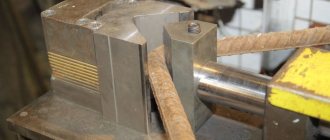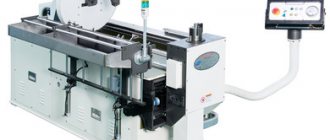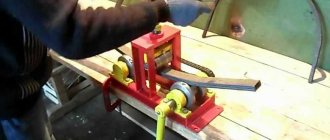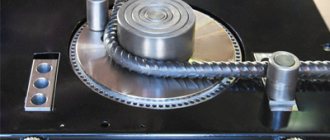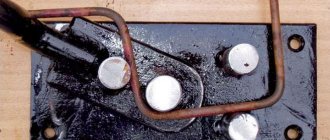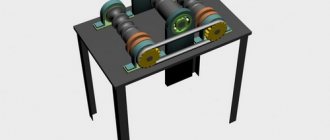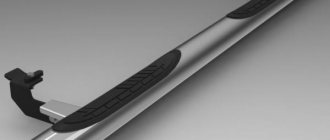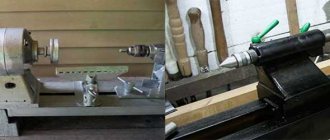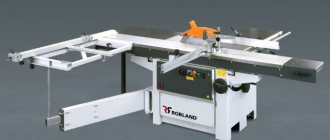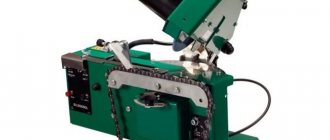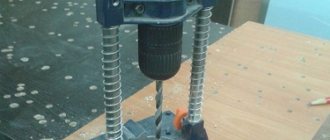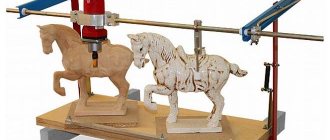When carrying out construction work, in most cases, it is necessary to erect concrete structures with the assembly of a reinforcing frame made of reinforcement. To create a reinforcing frame, you need both straight rods and bent rods in the form of clamps, “escos”, “pawns” and other structural elements. Manually bending steel bars with high precision is problematic, and buying a special machine for bending reinforcement for this purpose is not financially profitable. Therefore, making a reinforcement bender with your own hands will be an excellent solution.
Useful tips
Do not try to bend the reinforcement with your bare hands by stepping on it.
Even thin pins will require at least a vice mounted on a workbench and a hammer. Refusal of devices and a reinforcement machine is fraught with a high risk of injury - there have been cases when such “dared souls” were seriously injured, after which they were taken away by ambulance. Do not bend the reinforcement with jerking movements. The process must be smooth: steel, no matter how ductile it is, experiences tension on the outside of the bend angle and compression on the inside. Jerks and bending of rods too quickly violate cold bending technology. The rod heats up, causing additional microcracks at the bend. The jerk can cause the material to weaken and even break.
The bend should be smooth, and not polygonal and “wrinkled”, like heating and water pipes that are heated at the bend using gas welding or a blowtorch. Do not try to heat the bendable rod in any way - in a barbecue, on a fire, on a gas burner, by leaning it against a hot heating element on an electric stove, etc. Even pouring boiling water on it is not allowed - the rod must be at the same temperature as the air around it.
If you are unable to bend the rod, cut and weld both parts at the ends, at a right angle or another. Simply tying such pieces in places of constant shock-tension load (foundation, interfloor ceilings, fence) is unacceptable - the structure will delaminate in a few years, and the structure will be considered unsafe and dangerous for people to live (or work) in it. Do not use a rebar bender that is not designed to handle the required bar thickness. At best, the machine will bend; at worst, the supporting-moving part will break, and you will get injured or fall due to excessive force applied to the machine.
If the machine for fittings is assembled using bolted joints, make sure that the bolts, nuts, and washers are made of high-quality steel, as are the angles, rods, and profiles themselves. Often construction stores and hypermarkets sell fasteners made from cheap alloys in which the steel is diluted with aluminum and other additives that worsen its properties. You often come across low-quality bolts, nuts, washers, and studs. Check them carefully. It’s better to overpay a little, but buy good bolts made of alloy steel or stainless steel, than to use those made of “plasticine” steel, which easily deforms with any noticeable force.
Avoid fasteners made from consumer goods - these are suitable, for example, for fixing roofing iron and plastic sheets, once screwed to beams and resting on them. But such bolts are not suitable where constant impact load is required.
Do not use a thin-walled profile used for installation of plasterboard floors and siding panels to make a bender. They can’t even bend a 3-mm rod - the corner itself is deformed, and not the bending reinforcement. Even several of these corners, nested one inside the other, will make the structure very problematic; bending with such a dubious device is unacceptable. Use a profile of normal thickness - made of the same steel as the rods themselves. Ideally, there is a piece of rail for the device frame. But this is very rare.
A well-made reinforcement bender will quickly pay for itself. Its primary purpose is to make a frame for the foundation of a private house and extensions, and a fence as a fence. And if you are also an experienced welder, you will begin to bend fittings to order, as well as weld doors, grilles, and fence sections from it, then such a device will allow you to earn extra money.
To learn how to make a reinforcement bender with your own hands, see below.
Let's sum it up
Having decided on the design of the device, you can independently make a bending mechanism designed to give steel bars the required shape. It is important to take a responsible approach to developing documentation. You should use verified drawings from which the bending equipment was manufactured, or create a sketch of a full-scale sample yourself. There is a wide field of activity available for home craftsmen. The result is a self-made bending device, the use of which will save money.
Do-it-yourself manual reinforcement bender. Drawing, description
In order to make a simple reinforcement bender you will need:
- steel base, which can be used as a part of a steel sheet with a thickness of at least 6 mm;
- steel angle with dimensions from 40×40×2 and a length of at least 4...5 times the length of the largest horizontal dimension of the reinforcing bar - rotary lever (the longer the lever, the lower the bending force);
- a rolling bearing unit in which the drive arm will rotate;
- reinstallable stops - steel angles fixed in the drive lever;
- guides - bushings made of tool steel type U8, freely rotating on their axis. To properly guide the workpiece along the base, there should be two of them, but for the simplest work one is enough. It is better to harden the bushing to HRC 50…55;
- wooden handle mounted on a lever.
Installation of such a bender is simple and does not require the use of welding equipment. The base is securely fixed to the workbench, after which the desired size of the corner is selected - a blank for the swing arm. Grooves are milled or drilled into it for installing stops, the locations of which correspond to the dimensions of the required reinforcement (however, a through groove can also be provided). The bearing and guide bushings are attached to the desired location on the base.
Using such a device, you can perform horizontal and vertical bends at arbitrary angles. To increase accuracy, you can provide a manual reinforcement bender with a dimensional scale.
How does a manual bending machine for reinforcement work?
The design of a homemade bending device is simple. A small-sized device for bending reinforcement includes the following parts:
- desktop made in the form of a steel plate 6–8 mm thick;
- stops fixed on the base that limit the movement of the rod;
- a rotating lever with a pressure roller that deforms steel bars.
A simple design is also possible, consisting of a car jack to which a punch is attached, and a vertical stand with movable supports attached to it. This version of the device is portable. The mechanism allows you to easily bend the reinforcing bar, which touches the movable rollers and bends when the jacking rod moves.
Requirements for bending reinforcing bars
For bending reinforcement of large cross-sections, powerful factory-made machines are used; for rods of small cross-sections, you can use hand-made devices made by yourself. Such homemade devices are quite suitable for bending mounting loops, hooks, and tabs. Homemade devices are used for bending rods with diameters of no more than 14 mm when it is necessary to bend small batches of reinforcement. Most often popular among private developers.
To maintain the performance characteristics of the rods when bending, the following conditions are observed:
- The bend angle should not be less than 90°.
- The radius of rounding at the bend is at least 10-15 diameters.
- The equipment used must correspond to the diameter of the bars being processed and the strength class of the reinforcing steel, otherwise folds may form on the inside of the resulting angle, and cracks on the outside. Also important points are: correct adjustment of the device and reliable fixation of the rod.
It is not recommended to practice traditional methods using high-temperature effects, including the following steps:
- using a grinder to cut the bend of the reinforcing bar;
- heating the bend with a blowtorch or other open flame source;
- bending to the required angle.
When using this method, mechanical characteristics are reduced at the bend due to cuts and exposure to high temperatures. When exposed to loads on such a rod, it may collapse. If the project does not have permission to use this bending method, it is not recommended to use it.
Bending steel reinforcement - process features
At any construction site today you can see various equipment, many tools and devices, and almost every one of them has a machine for bending reinforcement. This is no coincidence: the most effective technology for strengthening fragile concrete structures, protecting them from destructive loads in compression, tension and bending, is reinforcement, which is performed using metal rods - reinforcement. Without a high-quality reinforcement frame, it is almost impossible to build reliable concrete walls and foundations.
It would seem much easier to reinforce corner concrete structures and adjacent wall areas using straight reinforcing bars. However, in this case, the concrete structure will be greatly weakened and may delaminate. In addition, this is a gross violation of building codes. In any corner concrete structures, it is necessary to use only bending, with an overlap of at least 80 cm on each side. A machine or a simple device for bending metal rods is also useful if you need to quickly produce connecting elements of various types - hooks, claws, etc.
When bending steel bars used for reinforcement, it is very important to know how to bend foundation reinforcement so that it does not lose its strength characteristics. To comply with this requirement, it is necessary to perform such an operation only mechanically, using special machines for cutting and bending reinforcement. In this case, it is important to ensure that the bend angle is not sharp, and that the radius of curvature at the bend is from 10 to 15 diameters of the rod itself. It should be remembered that a steel reinforcing bar bends without losing its strength characteristics up to an angle of 90 degrees, then the strength indicators begin to decrease.
When bending steel reinforcing bars with your own hands, two mistakes are often made:
- a notch is made at the bend site using a grinder or other tool;
- The section of the reinforcement where the bend will be located is heated using a gas burner or blowtorch.
After such procedures are completed, some primitive means for bending is used: a heavy hammer, a sledgehammer, a piece of pipe, a vice, etc. These bending methods lead to a significant weakening of the reinforcement, which can cause the destruction of concrete structures. In such cases, you should always remember that you need to bend the reinforcing bars without violating their integrity and only if they are in a cold state.
In general, everything here is expensive and serious - full automation and many settings. For home craftsmen, this video is provided for informational purposes only. Since spending 130-180 thousand rubles on such a unit for non-professional use does not make any sense.
Homemade machine design
The manual machine has a fairly simple design, and to make it yourself, it is enough to refer to a competent drawing of the device. The basis is a metal frame, to which a round pin or an ordinary corner is welded. Another element is the rotating platform, to which the lever, bending and central pins are welded. The distance between the pins is dictated by the maximum diameter of the reinforcement being processed. In order to be able to bend rods Ø6−12 mm on such a manual machine, the legs of the frame are securely fixed to the floor.
All elements of a portable homemade machine are fixed on a massive plate. This, also portable, plate can be secured at the work site with bolted joints or with the help of special pins welded to its lower part. A homemade machine can only be used for bending metal rods whose diameter is no more than 10 mm.
Technology for performing the work (option No. 1)
To get a machine for bending metal rods, you need to prepare the following materials:
- sheet iron with a thickness of 10 mm for the manufacture of the base;
- sheet metal with a thickness of 6 mm for the hinge;
- corner with a thickness of 10 mm for the base or frame;
- reinforcement studs with a diameter of 50 mm or more for stops;
- a metal pipe that acts as a lever. Recommended length is about 50 cm, diameter is 25 mm.
After determining the required dimensions of the machine, they begin to mark the metal parts and connect them using a welding machine. The base of the equipment is secured with pins and hinges with a lever. The device body itself is installed at a height that corresponds to the height of the worker.
Preparation of materials and tools
Before making a bending machine, read the available drawings or make your own. The thickness of the reinforcing rod and their number are important as initial data. The safety factor of the device, which exceeds the effort required to bend the existing reinforcing bars, is chosen to be at least three times larger if the business is put into production and you are bending reinforcement for a large number of customers, or a grandiose construction project is planned.
If the drawing is selected, the following tools and accessories will be required.
- Grinder with a set of cutting and grinding discs. Without it, sawing a massive profile and reinforcing bars is difficult.
- Electric drill and suitable high-speed steel drill bits.
- Welding installation and electrodes.
- A hammer, a sledgehammer, powerful pliers, a chisel (file), a center punch and several other tools that no mechanic can do without.
- Vise for workbench. Since the structure is powerful, it must be fixed.
The materials you will need are:
- corner profile (25*25 mm) 60 cm long;
- steel rod (diameter 12-25 mm);
- bolts 2*5 cm, nuts for them (20 mm in inner diameter), washers for them (can be screwed).
The device you will make weighs more than one kilogram. The reinforced weight and massiveness of the entire structure will provide the strength required for bending the reinforcement.
Design and purpose of a bending machine
In the simplest case, a machine for bending reinforcement includes a casing and a working mechanism. The first serves as the base on which the second is attached and rotates. Without a reliable base, you will not be able to bend the reinforcement well - it must be securely fixed. The movement of the reinforcing rod (except for that part of it that bends in the desired direction) must be completely eliminated.
There are at least a dozen different drawings of the simplest homemade manual bending machine - they differ in the size of the working parts of the device.
But all these reinforcement benders are united by a common principle: the reinforcement cannot be bent sharply and at an acute angle - no matter how thick or thin the rod itself is. The basic rule for bending reinforcement is that the radius of the bent section must be at least 10 and no more than 15 diameters of the rod itself. An underestimation of this indicator threatens to break the reinforcement, which will sharply worsen the operational parameters of the frame assembled from rods. If it is too high, the structure, on the contrary, will not have sufficient elasticity.
A device (manual machine) for bending reinforcement with your own hands
The principle of operation of all designs of manual devices for bending metal (sometimes called manual machines) is the same: a “lever of the first kind” is used. If you have:
- the desire (initiated by need) to create a bending device for reinforcement;
- plumbing skills;
- necessary tools (including a bench with a vice)
- then you have come to the right place. With our hint, you can create a device (manual machine) for bending reinforcement with your own hands. The device of the proposed design can bend steel reinforcement with a diameter of ≤ Ø 15 mm.
What tool will you need?
In addition to a set of plumbing tools, which every skilled owner has for performing “work around the house and in the country,” you will need:
- any welding machine. You will perform MMA welding on it;
- electric drill;
- cutting machine (angle grinder) and cutting disc “for steel”;
- abrasive machine.
Description of the bending device
The bending device consists of two parts:
- motionless. It's called the base;
- mobile. It's called a lever.
The processed rod is placed between the mandrels and is deformed under the influence of a pin installed on the lever. The amount of force is determined by the length of the lever handle (usually about 500 mm long) and the physical capabilities of the mechanic. If necessary, provision should be made for extending the handle (for example, with a hollow pipe).
Manufacturing technology of fixtures for bending reinforcement
It is necessary to prepare 3 mandrels Ø 20 mm and a pin Ø 25 mm, 50 mm long each (see drawings). The lever should fit freely onto the pin. This is achieved by processing a size of Ø 25 mm on the pin using an abrasive machine.
Base
For the base, we cut out a steel plate with a thickness of ≥ 10 mm (see plate drawing below). Drill holes on it:
- Ø 20 mm for mandrel;
- Ø 25 mm for pin.
The basis of the bending device.
If you are the happy owner of a durable and strong workbench, you can drill 4 holes Ø 8...10 mm (indicated Ø 8 mm in the drawing) in the base to attach the fixture to it. If the strength of the workbench is in doubt, then the base should be welded to a corner 100 x 100 (mm) with a length of 1000 mm and the above holes should be drilled in the corner for fastening. Insert a mandrel and a pin into the drilled holes Ø 20 mm and Ø 25 mm (as shown in the drawing) and weld.
Lever arm
For the lever, we cut out a steel plate with a thickness of ≥ 10 mm (see plate drawing below). Drill holes on it:
- Ø 20 mm for mandrel;
- Ø 25 mm for pin.
Bending device lever.
We weld a mandrel and a handle Ø 20 mm and length 550 mm to the lever. To prevent industrial injuries, you can put some kind of protection on the end of the handle (for example, a plastic champagne cork).
Conclusion
After all work has been completed, the welding area should be cleaned from welding slag with a carriage brush. All sharp edges should be “filled” using a fine file. The device will be used outdoors, and therefore an anti-corrosion coating should be provided - in this case, pentaphthalic paint of the "PF" type is sufficient (just do not forget to prepare the surface - clean it with an appropriate solvent). At the junction of the lever with the pin, the surfaces should be lubricated with any grease (solidol, autol, grease, etc.). The condition of this unit should be constantly monitored and lubricated (this will greatly facilitate your work and extend the “life” of the device).
Operating rules
The principle of operation of this device is extremely simple - it is easy to understand if you look at the photograph. Simple safety rules should be followed:
Video
The video shows how it works, the machine is a little different, but the essence is clear.
Compliance with these simple requirements will save your health.
;
Address: 117997, Moscow, st. Obrucheva, house No. 21;
Phones: +7-(495)-647-92-71, +7-(495)- 647-69-81;
The company sells a manual machine for bending reinforcement with a diameter of up to 16 mm. Cost: 3999.00 rubles.
Is it possible to make a bending machine with your own hands?
A do-it-yourself reinforcement bending machine has a fairly simple design, but is capable of performing a large amount of work. Equipment of this type can be used for any purpose, as it is easy to use. Its design is based on a frame. It is to this that the thrust block and lever are attached, with the help of which the bend can be made.
To make such a device yourself, you need to have basic welding and plumbing skills. Otherwise, it is impossible to ensure the quality of all connecting nodes. Also, if you cannot find good stops that have a sufficient diameter, you need to work with a lathe. As an alternative, large diameter reinforcing bars can be used.
To correctly and easily carry out all the necessary operations, you should prepare the following tools:
- welding machine;
- hammer and file;
- Bulgarian;
- an electric drill equipped with metal drills.
Reinforcement bending machines
According to the type of force with which the bending force is created, machines are classified into:
- manual,
- hydraulic,
- pneumatic,
- electromechanical,
- electromagnetic.
Using hand-held machines, it is possible to produce products from reinforcement with a diameter of up to 14 mm. If you need to manually bend reinforcement with a diameter of more than 14 mm. Then you should use the correct plate and a set of special keys. Manual production of curved reinforcing bars is advisable only for small volumes of work. Increasing the productivity of such manual labor is achieved by using machines for simultaneous processing of several reinforcing bars.
Other types of machines are distinguished by high productivity, precision of the manufactured configuration and the ability to bend reinforcement of any diameter. At the same time, they usually have various functions that increase productivity, small dimensions and the ability to operate in an automated mode.
Bending reinforcement using special equipment allows you to avoid twisting of the product around the central axis. In addition, products bent in this way are characterized by high accuracy of geometric shape. This achieves a reduction in time and labor costs for performing operations to install reinforcement parts in the required design position, which creates a positive economic effect on any construction site.
More information
When creating the structural frame of concrete work, bending and cutting of reinforcement (steel rods to strengthen the concrete) is very often necessary. It is an easy-to-work material that is often used in landscaping, art, and other projects that require metal that bends easily. Conventional reinforcement is distinguished by its nominal diameter, which varies in increments of 1/8 inch (that is, “number 4” reinforcement has a nominal diameter of 1/2 inch (15 mm)). Reinforcement up to number 4, as a rule, can be bent and cut by hand. Larger diameter rebar is not usually used except for technical or industrial concrete work and usually requires special equipment such as hydraulic shears and bending machines.
For this article, we will assume that 1/2 inch rebar (number 4) is used, which is common and used in landscaping and residential concrete work.
- Tight bends almost always require the use of a vise, jig, or special tool.
- The reinforcement can be heated with a torch for precise control of the bending process. However, this is unlikely to be needed when working with reinforcement having a nominal diameter of 1/2 inch (15 mm).
What rebar bending tools are available on the market?
The market offers household as well as industrial models of special bending equipment. Noteworthy is the Afacan manual reinforcement bender, offered in the following modifications:
- Afacan 10E. Works with rods with a cross section of 0.6–1.2 cm;
- Afacan 12E. Bends rolled products with a diameter of 1–1.2 cm;
- Afacan 16RT. Deforms rods with a diameter of up to 1.6 cm.
Manual universal benders are also offered, designed for bending reinforcing bars with a diameter of 0.6–2 cm.
Manual bending machines Afacan
It is possible to purchase or rent the following types of industrial bending plants:
- SGA-1. With an installed drive power of 3 kW, it easily deforms rods with a diameter of up to 3.2 cm, ensuring their bending by 160 degrees;
- GW-40. The design of the device with a three-kilowatt drive allows you to bend rolled metal products with a diameter of up to 4 cm by 180 degrees;
- G-40. The kinematics of the device, equipped with a step transmission mechanism, allows you to repeatedly deform a rod with a cross-section of up to 3.2 cm;
- G-50. This industrial installation, equipped with a 4 kW drive station, deforms reinforcing bars with a diameter of up to 5 cm.
When deciding to purchase bending equipment, consult with specialists. They will give professional advice and help you choose the right device depending on the tasks at hand.
Machine for bending reinforcement - classification and design
A machine for bending reinforcement is equipment that allows you to give the required configuration to reinforced metal products.
Homemade machine for bending reinforcement
Devices are divided into types depending on the following criteria:
- design features;
- drive type;
- diameter of the bending rod.
The machine for bending reinforcement is of the following types:
- mechanical device with manual application of force;
- mechanized equipment powered by an electrical network.
Manually operated equipment has a number of advantages:
- simple principle of operation, reminiscent of the functioning of a pipe bender;
- reduced weight of the bending mechanism, ranging from 12 to 20 kg;
- mobility, allowing, if necessary, to quickly move equipment;
- low cost, allowing you to make a machine for bending reinforcement with your own hands.
Manual reinforcement bending machine Stalex DR-16
Mechanized equipment with an electric drive is used in industrial enterprises for the serial production of bent elements. The industrial reinforcement bender is distinguished by the following points:
- increased productivity, allowing you to bend 5-6 reinforcing elements in one minute;
- the ability to bend industrial reinforcing metal with an increased diameter;
- increased power of the electric drive station to 5 kW, allowing for significant efforts;
- the ability to work in automatic mode with remote control, as well as manual control;
- a stationary structure that provides for operation of the equipment at the installation site without moving;
- weight increased to 0.5 tons, making transportation difficult without the use of lifting devices;
- a sufficiently high cost that allows you to purchase the device only for industrial use.
In industrial enterprises, the cutting process is often combined with the deformation of rolled reinforcement. For this purpose special equipment is used. The design of such units uses:
- powerful hydraulic drive;
- electromechanical systems;
- electromagnetic mechanisms.
Machine for bending reinforcement with end cap TCC GW 40A
Depending on the diameter of the metal that needs to be deformed, bending devices are divided into the following groups:
- lightweight, bending rods with a diameter of up to 2 cm;
- medium, bending metal rods with a cross-section of up to 4 cm;
- heavy, designed for bending workpieces with a diameter of up to 9 cm.
Improved bending quality is provided by hydraulic devices. When the metal is deformed, there is no cracking or formation of folds, which are a source of internal stress.
2 Devices for bending reinforcing bars
Over the history of the development of construction and metalworking technologies, humanity has invented more than one device for bending reinforcement. The principle of operation is the same for all, but the difference lies in the design of the equipment and the diameter of the bending reinforcement, depending on the model.
The part to be changed is fixed between the central and thrust roller (shaft) of the device. The third roller (bending) bends the metal in the desired direction to the required angle. Rounding can be done either clockwise or counterclockwise. An obstacle to deformation along the entire length is a thrust shaft, which does not allow the unused part of the workpiece to rotate or move.
There are two main equipment options:
- manual models;
- with mechanical drive.
Drive machines, except for special ones, operate according to the same scheme. The working body is a disk, which is mounted on a vertical shaft and rotates in a horizontal plane. The bending and central fingers are installed on the disk; reinforcement is placed between them. The thrust roller is fixed to the stand - the reinforcement rests against it when the disk rotates and bends around the central bushing under the action of a bending pin that moves along the outer surface of the rod.
The machines differ in power, productivity and are divided into 3 groups depending on their purpose:
- for light reinforcement – rod diameter 3–20 mm;
- heavy – 20–40 mm;
- super heavy – 40–90 mm.
Such a device for bending reinforcement is capable of bending several rods at the same time. Equipment for diameters 3–90 mm is also produced. If you need to make a complex structure with variable bending angles, then a hydraulic machine is best suited. It allows you to bend rods more efficiently, without the formation of kinks and folds on the surface of the workpiece that accompany metal stress. This machine can be used to bend at an angle of up to 180°.
The choice of bending equipment is determined by the diameter of the reinforcement and the volume of work. Before you start processing the metal, you should take into account that different parts of the rod are subjected to different stresses, the outer part is subjected to tension, and the inner part is subjected to compression. The wrong choice of machine or its illiterate use can lead to not only the appearance of folds and kinks, but also to damage to the reinforcement. Therefore, it is necessary to accurately determine all dimensions of the workpiece, appropriately configure the equipment and correctly fix the rod in it.
How to bend reinforcement without a special device
Here it is worth knowing that when trying to bend, especially alloyed reinforcement, with your own hands you need to consciously calculate your actions, otherwise this can lead to serious injuries. Alloyed rolled metal, if you try to deform it, will try in every possible way to spring back and can cause irreparable harm to your health. So be careful and attentive.
Let us highlight the three simplest ways to bend reinforcement with a diameter of up to 8 mm yourself without the use of special devices, namely:
Using two pieces of metal pipe. So, we will need tubes with a diameter of 15 mm with a length of 0.5 and 1 meter, which we put on the fittings. We stand on a half-meter piece of pipe with our feet, and, accordingly, we begin to lift the meter piece to the bend angle we need.
- If a five-centimeter piece of pipe 25-32 mm in diameter is electric welded to a one and a half meter metal pipe of 32 mm in diameter or a 50 mm steel angle, you will get a universal bending lever. All that remains is to either stand on the reinforcement or rest it against something strong.
- Not very long pieces of reinforcement can be bent using a large vice and a sledgehammer. Only with this method you shouldn’t rush and you need to hit with a little force, stretching the process, otherwise you can simply break the reinforcing bar.
The main disadvantage of using such methods for bending reinforcement is that the turning radius is quite large and often the angle turns out to be somewhat curved and does not lie with its sides strictly in the same plane.
Technology for performing work (option No. 2)
To make your own machine for bending small-diameter steel bars, you need to follow these instructions:
- Pieces 5 cm long are cut from corners with shelf sizes of 25 and 32 mm. The same actions are carried out with a square profile and reinforcement with a diameter of 12 mm.
- Two pieces of reinforcement are inserted inside the profile and welded.
- The corners are also connected to each other using a welding machine.
- The resulting blanks are welded and installed in the thrust part of the jack. The location of the punch should be carefully controlled, since horizontal deviations are unacceptable.
- A T-shaped frame needs to be made from a rectangular profile. The dimensions of this structural part of the equipment are as follows: height – 40 cm, width – 30 cm.
- You can ensure a stable position of the jack during bending using stops that need to be welded to the horizontal part of the frame.
- It is necessary to weld two corner pieces with a flange size of 25 mm onto the side of the frame. Hinges for the gates are attached to their surface, which will later act as stops. Calculate the distance between the end of the punch and the stops to match the diameter of the reinforcement that will be used in the future.
Bending machine drawing
How to make a device for bending reinforcement
Variant of reinforcement bender made from improvised means
Before starting production, it is necessary to make detailed drawings of the components of the future device. To do this, it is recommended to familiarize yourself with ready-made samples on the Internet, made according to a standard scheme, or choose some other technique than bending reinforcement.
A simple do-it-yourself reinforcement bender is easiest to do, based on the general principle of operation of this kind of device, namely, consisting of three main parts:
- massive base,
- rotating mechanism in the form of a large lever,
- strong support.
To make such a device, improvised materials and tools available in any normal garage are quite suitable. So, let's prepare the necessary tools for this, here we will need:
- angle grinder with cutting wheels and grinding disc,
- electric drill with a set of metal drills,
- electric welding machine with electrodes,
- standard set of hand tools.
Although an important step is the preparation of components and assemblies, here we will try to adapt various available materials. As a last resort, what is missing can be borrowed either from a neighbor or purchased in addition on the construction market.
Sequencing
- Let's make the base. To do this, we take sheet metal 3-5 mm thick, measuring 100 by 200 mm, or you can take a piece of channel size 10-15, 200-300 mm long. We drill holes in the corners of the base to allow fastening to a workbench or other massive object. An axial stop is firmly welded in the center of the structure using electric welding. This is a steel shaft with a height of 50 mm and a diameter of 14 mm. For this part, you can take any M14 bolt of suitable size, the head of which must be sanded off, leaving a thickness of 3 mm - this will make it possible to create a strong welded connection with the base.
- We make a rotating mechanism. A steel strip 5 mm thick, 50 mm wide and at least one meter long is suitable for this. In the absence of a strip of the required length, you can take a shorter one, but weld the length of the lever using a steel pipe 32-50 mm in diameter. To one edge of the strip we electric weld a piece of metal pipe 50 mm long and 15 mm in diameter, which will fit like a roller on the axial stop. We retreat 50 mm from the roller along the longitudinal axis and weld a rotary stop, for which an M10 steel bolt, also with a pre-ground head, is suitable. You can also make and put a ring on the rotary stop, which will serve as a roller, which will improve the operation of the device. As an option, you can make a lever from a 50 mm steel angle; to do this, you need to cut off 50 mm of the shelf vertically at the point of attachment to the axial stop; the remaining part of the shelf will serve as a rotary stop.
- We electric weld a fixed stop to the base, for which a 50 mm piece of angle 50-100 mm long is suitable. The place of its attachment should be 100-200 mm from the axial stop with a displacement from the central axis of the base of no more than 20 mm, which is determined by the thickness of the reinforcement.
- We assemble the finished structure. We firmly attach the bases of our finished device to a mechanic’s workbench or other similar massive object in the surrounding environment. We put the rotating mechanism roller with a lever on the axial stop.
- We run in the finished machine for bending reinforcement and check its operation at idle, using soft metal for this. If everything works, then we begin to manufacture the parts we need from the reinforcement.
If the machine for bending reinforcement has its own stationary frame, then it is worth advising to make a couple of additional improvements to it, namely:
- apply linear markings on both sides of the axial stop, which will allow you to measure the length of the bent part of the bar without using a tape measure;
- Apply radial markings of the main angles of 30, 45 and 60 degrees around the axial stop, which will also make working on such a machine much more convenient.
Corner machine
The procedure for making a device for bending reinforcement from a corner:
- The corners are cut to size as indicated in the drawing.
- The steel U-shaped profile is cut so that its length is 1 m. It will serve as a bed.
- A pin made of thick reinforcement is welded to the frame in the middle.
- We cut off a piece of pipe whose diameter allows it to be placed on the welded pin.
- A corner is welded perpendicular to the welded pin. Then a hole is drilled in it for the internal diameter of the pipe.
- The corner with the pipe is put on the pin. Then mark the place for welding the corner piece, remove the moving part and weld the second part of the corner.
- A piece of reinforcement is welded to the end of the movable structure. It will act as a lever. You need to attach a comfortable handle to the end opposite to the mount.
- Reinforcing legs are welded to the frame.
- It is recommended to lubricate the bending axis to extend its service life by reducing friction of parts during operation.
There is a simpler design for a reinforcement bender made from a corner. You need 2 corners of 80 cm each, with a metal thickness of at least 5 mm. You will need studs, 3 pieces of 10-15 cm, and one 20 cm.
The procedure is as follows:
- We weld two pins to one of the corners, with the help of which we will attach the corner to the table.
- We weld a piece of tube on the edge to the second corner. This will be our moving part.
- We weld a pin to the other end of the corner. We put a piece of pipe on it and screw two nuts. This will be our handle.
Simplicity of design and mobility allow it to be transported from one construction site to another and attached to any table; the machine will be an excellent assistant in reinforcing strip foundations, floors and other reinforced concrete structures. This reinforcement bender allows you to bend reinforcement with a diameter of up to 14 mm.
Devices for tying reinforcement
How easy and fast the knitting will be depends on the tool you use. You can twist the reinforcement by hand, but it is difficult and time-consuming. There are various devices for this. Simple and more complex.
Hooks
The most widely used are various hooks. There are quite a few of them in stores; they are made independently from any piece of wire of a suitable diameter.
Hooks for tying reinforcement have different lengths, handles and shapes
There are simple ones, with straight or curved steel handles. They differ in the angle of bend of the handle, the shape of the hook, and its size. How to decide which is more convenient? Just try to work. No other way.
There are mechanical hooks - they have a spiral built into the handle. There is no need to rotate them when knitting. Just pull up. The handle slides along the screw groove, turning the hook. Watch the video to see how it works.
Ticks
There is a special tool in which pliers and a mechanical hook are connected. Thicker single wire can be used for knitting with them. It is placed under the intersection of the reinforcement bars and inserted into the pliers. They are clamped in the clamp, the excess wire is bitten off. The next step is to pull the handle a few times. The pliers begin to rotate, tightening the knot. Such a device costs $40-60. How much you need it - decide for yourself.
Mechanical handle pliers
There are other ticks. Also special for knitting, but they are rotated by hand. You don’t need a lot of turns here - the pliers allow you to grab the wire close to the reinforcement and only make one or two turns.
They differ from ordinary ones in the shape of the cutting part - they must hold the wire. Professional knitters on construction sites work using just such a tool. They say that with pliers, tying goes twice as fast as with a hook and a gun. There are two more advantages:
- No need to cut the wire. It is wound into small skeins, which are held in the left hand.
- There is no overspending: “tails” of a few millimeters remain. For large volumes this is important.
When knitting a reinforcing belt, special pliers are used.
They have a different shape of sponges: they hold the wire. Believe it or not - it's up to you. But it looks amazing.
Gun
Devices for automating knitting are available for sale. These are the so-called knitting guns. They are “charged” by wire and run on batteries. All human involvement consists of bringing the gun to the joint and pressing the trigger guard. A second or two, and the gun will wind several turns around the intersection of the bars and make a knot.
Buying such a gun to tie one foundation is an unjustified waste of money. They are rarely purchased even by those who do this professionally. Their cost is considerable: no less than $500.
Metal garden crafts or what to do with old shovels - photo ideas
It’s not at all difficult to create crafts for the garden from metal with your own hands if you have, for example, old shovels or other garden tools that have expired. After all, country crafts made from shovels do not require special skills and are made using simple welding methods.
What can be made from an old shovel at the dacha
With the help of these photos with ideas, you will easily understand how to decorate your dacha, and at the same time get rid of unnecessary junk in the barn. And old shovels that have served their purpose will turn into interesting masterpieces of landscape design, fitting perfectly among flower beds and garden topiary figures.
Crafts made from shovels very successfully create images of various animals. And while walking through the garden, it will be very unusual to meet a heron standing near the dacha pond or a ladybug crawling towards the onion alpine hill.
Crafts from shovels photo
A family of shovel owls, a cat with flowery fur, an aquarium fish and even a goat will get along well in different parts of the garden along with a homemade garden scarecrow. Crafts can be painted with enamel paint, after removing the rust from the tools, coated with metal varnish, or left in their natural rusty form.
